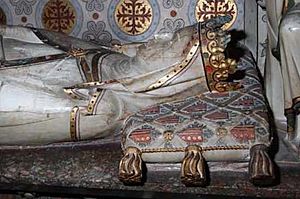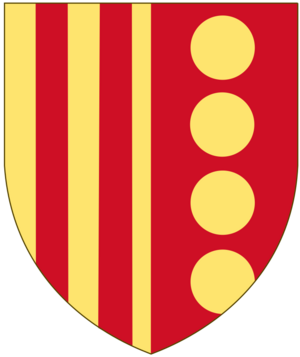Elisenda of Montcada facts for kids
Quick facts for kids Elisenda of Montcada |
|
|---|---|
 |
|
| Queen consort of Aragon | |
| Tenure | 1322–1327 |
| Born | 1292 |
| Died | 19 July 1364 Monastery of Pedralbes |
| Burial | Monastery of Pedralbes |
| Spouse | James II of Aragon |
| House | House of Montcada |
| Father | Pere II Ramon of Montcada, Lord of Aitona and Soses |
| Mother | Elisenda de Pinos |
| Religion | Roman Catholicism |
Elisenda de Montcada (born around 1292 – died 19 June 1364) was a queen of Aragon. She was the fourth and last wife of James II of Aragon. She helped rule Aragon as a "Queen-Lieutenant" when her husband was away, from 1324 to 1327.
Elisenda and James II together founded the Monastery of Pedralbes. This was a special convent for nuns called the Poor Clares. After James II passed away in 1327, Elisenda lived right next to the monastery for the next 37 years of her life.
Contents
Early Life and Family
Elisenda de Montcada was likely born in Aitona. Her father was Pere II Ramon Montcada i d’Abarca, who was the Baron of Aitona. Her mother was Elisenda de Pinos.
Elisenda came from the Montcada family, which was one of the most important and noble families in Catalonia. They were very close to the royal family. Elisenda had three brothers: Ot, who inherited the Aitona lands; Gastó, who became a bishop; and Guillem Ramón. Elisenda's great-grandmother was Constance, who was an illegitimate daughter of Peter II of Aragon. This made Elisenda and her husband, James II, distant cousins.
Becoming Queen and Regent
After James II's third wife, Maria of Cyprus, died, he quickly wanted to marry again. Just one month after Maria's death, he started the process to get special permission to marry. This was needed because he and his chosen bride were related. The bride he chose was Elisenda of Montcada. The king was very eager for this marriage to happen.
Elisenda married James II in Tarragona on 25 December 1322. The king gave Elisenda income from several towns, including Berga and Tortosa. He also gave her brother Ot some lands. Elisenda was about 30 years old, and James was around 55.
Elisenda became the stepmother to James's ten children from his second marriage. She and James did not have any children of their own. She was especially supportive of James II's grandson, who would later become King Peter IV of Aragon.
They lived in the royal palace in Barcelona. Their life there was quite peaceful. Elisenda often gave advice on state matters, just like other queens before her. She was known as a mature, educated, beautiful, and very religious woman. Life at the royal court was friendly, even though King James himself could be very strict. From 1324, Elisenda acted as a regent, meaning she ruled in her husband's place when he was away from Aragon. Their marriage lasted five years until James died in November 1327.
A historian named Jesus Ernest Martinez Ferrando wrote that Elisenda's kind and religious nature brought comfort to the king in his final years. Their conversations helped him through his difficult times.
Elisenda chose Barcelona as her main home, even though other queens had lived in Tortosa. Since she had no children and the king became ill, Elisenda spent her time on religious activities and helping others.
Founding the Monastery of Pedralbes
Elisenda became very interested in building a new monastery for the Poor Clares nuns near Barcelona. When she told the king this, he was quick to agree. There was already a Poor Clares monastery nearby, founded by his second wife, Blanca of Anjou. The king only had one rule: the new monastery had to be built to honor the mother of God.
They first planned to build it in Valldaura, but then chose a place called Pedralbes. This name came from the white stone (`pedres albes` in Catalan) found in a quarry there.
Work on the monastery began in 1326 and moved very quickly. Perhaps James II felt his death was near and wanted his wife's dream to come true soon. After just one year, the main parts of the monastery were ready. The cloister, church, and living areas for the nuns were almost finished. On 3 May 1327, fourteen nuns moved into the monastery and chose Sobirana d’Olzet as their first abbess (the head nun).
A few months before he died, the king wrote his will. He confirmed the money and lands he had given to Elisenda. He also left her the gold crown he bought for their wedding, many jewels, fine fabrics, and dishes made of gold and silver.
Elisenda became a widow in November 1327. She had a small palace built right next to the monastery, but completely separate from it. She lived there for the remaining 37 years of her life. Even though she was never a nun herself, Elisenda had a lot of power over how the monastery was run. She was actively involved in decisions and worked hard to get special rights for the monastery.
For example, the city of Barcelona, through its governing body called the Consell de Cent, promised to protect the monastery if it was ever in danger. Elisenda wanted Pedralbes to be the most favored monastery so it would not have money problems after she died. During these years, the many royal gifts almost changed the simple, humble way of life that the Franciscan nuns were supposed to follow.
Elisenda also managed the building's decoration. Famous painters like Ferrer Bassa and the Serra brothers were hired to make the monastery beautiful. Elisenda also encouraged the paintings in the chapel of St. Michael, which were ordered by her niece, Abbess Francesca Saportella.
Even though she lived at the monastery, Elisenda still took part in some royal events. For example, she attended the ceremony to move the remains of Saint Eulalia to the Cathedral in Barcelona. She was with Maria of Navarre, who was the wife of Peter IV of Aragon, and Constance of Aragon, who was the wife of James III of Mallorca.
Death and Burial
Elisenda wrote her will on 11 April 1364. She passed away on 19 July of that same year. She left almost everything to the monastery, which was her main heir. She only left some items to other organizations, relatives, or friends. She asked for the palace where she lived to be torn down, which happened right away. An inventory of her room showed that she lived a simple life, even though she owned many jewels and fine fabrics that she later gave away.
Queen Elisenda's tomb is a beautiful example of Catalan Gothic art. It shows the two sides of her life. The tomb is built into a wall that separates the church from the cloister. It looks different from each side. From the church, Elisenda is shown as a queen wearing her crown. From the cloister, she is dressed simply, like a widow or a nun.
Legacy
The Monastery of Pedralbes is Elisenda's most important legacy. It is now a national monument and is open for people to visit.
Elisenda's picture is part of the Gallery of Illustrious Catalans at the Barcelona City Council.
A street in the Sarrià neighborhood of Barcelona is named after her: Passeig de Reina Elisenda de Montcada. There is also a train station called Reina Elisenda on line L12 of the Barcelona Metro. The station is about 0.7 kilometers northeast of the monastery.
See also
 In Spanish: Elisenda de Moncada para niños
In Spanish: Elisenda de Moncada para niños


